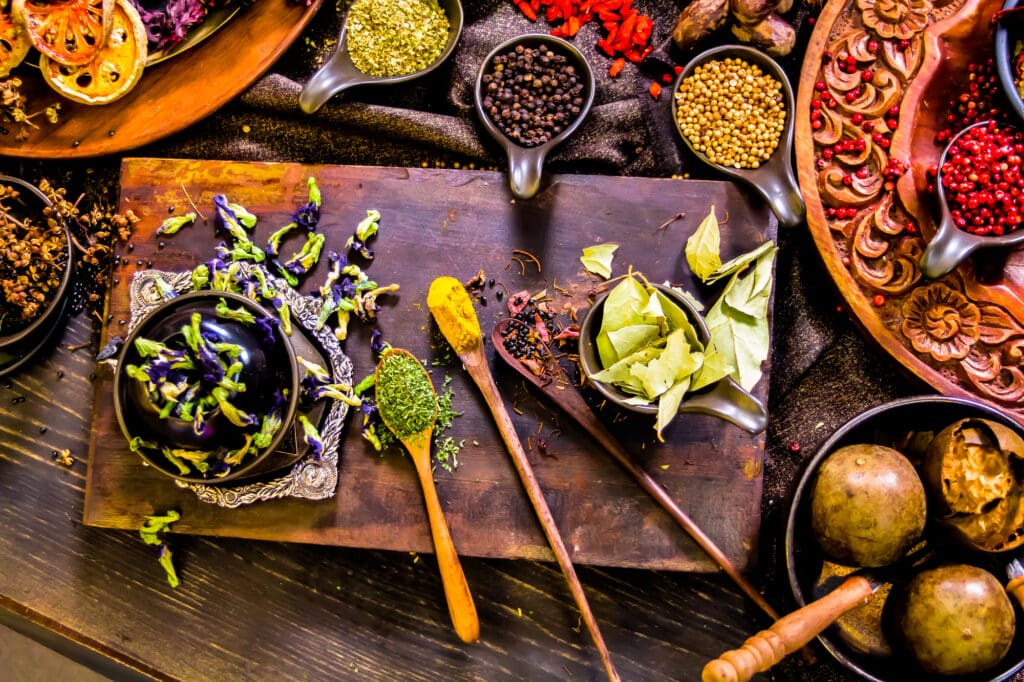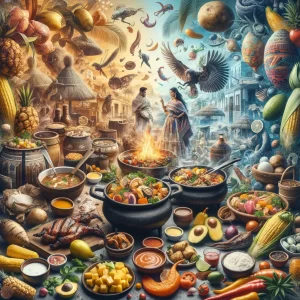The spice trade possesses a rich and significant history that has profoundly influenced global culinary practices and the flavors of cuisines worldwide.
From ancient trade routes to contemporary marketplaces, spices have not only transformed culinary dishes but have also played a crucial role in cultural exchanges, seasoning techniques, and health practices.
This article examines the origins of the spice trade, its global dissemination, and the substantial impact regional spices have had on various culinary traditions.
Additionally, it reveals the health benefits associated with these flavorful ingredients and discusses the importance of sustainable spice sourcing within today’s food landscape.
We invite you to engage in a comprehensive exploration of the historical and culinary significance of spices and their gastronomic influences on cultural cuisine.
History of Spice Trade and Its Influence on Global Culinary Practices
.jpg_00.jpeg)
The history of the spice trade constitutes a complex narrative developed over centuries of culinary exchange, in which regional spices have been instrumental in shaping global culinary practices, food traditions, and traditions across various cultures.
From the ancient spice routes that interconnected distant regions to contemporary gastronomy, the impact of spices has crossed geographical boundaries, culminating in a rich array of flavors that reflects taste diversity and culinary innovation.
As spices dispersed throughout the world, they not only enriched the flavor profiles of numerous dishes but also facilitated the evolution of culinary techniques, ingredient sourcing, and the appreciation of food that characterize today’s culinary trends and landscape.
What are the Origins of Spice Trade?
The origins of the spice trade can be traced back to ancient civilizations that recognized the intrinsic value of regional spices, which were highly sought after not only for their flavor enhancement and culinary heritage but also for their preservative properties and medicinal applications.
Civilizations such as the Egyptians, Greeks, and Romans played crucial roles in incorporating spices like cinnamon, black pepper, and saffron into their culinary practices, while simultaneously establishing extensive spice routes that facilitated trade across continents.
These routes connected distant marketplaces and fostered significant cultural exchange, enabling the sharing of culinary traditions and practices. For example, the incorporation of turmeric into Indian cuisine had a notable influence on neighboring regions, leading to its adoption in Middle Eastern and even Western dishes.
The exotic appeal of these spices significantly affected social and economic dynamics, shaping palates, flavor narratives, and recipes throughout history. This illustrates the profound interconnection between culinary practices and the rich tapestry of trade and cultural interactions.
How Did Spice Trade Spread Across the World?
The expansion of the spice trade across the globe was significantly facilitated by the establishment of complex spice routes that interconnected various cultures, resulting in substantial culinary influences and the globalization of food systems.
These routes, utilized by explorers and traders, traversed continents and oceans, enabling the transportation of spices such as cinnamon, cloves, and pepper from remote islands to thriving spice markets in Europe and Asia. As colonial powers extended their influence, the demand for these aromatic commodities increased, interweaving with local traditions and resulting in distinctive adaptations within regional cuisines.
For example, the introduction of indigenous spices transformed local dishes into flavorful fusions, highlighting the impact of trade on culinary diversity.
The spice markets evolved into not merely commercial hubs but also vibrant centers of cultural exchange, exemplifying the historical significance of global exploration and the dynamic interplay between diverse culinary practices and gastronomic practices.
Impact of Regional Spices on Global Cuisine
Regional spices have significantly influenced global cuisine by transforming flavor profiles and enhancing culinary traditions.
They are essential components in the preparation of iconic ethnic dishes and regional dishes across various cultures worldwide.
How Did Regional Spices Change the Flavor Profiles of Different Cuisines?
.jpg_01.jpeg)
Regional spices have profoundly influenced the flavor profiles of various cuisines, contributing to a rich tapestry of taste diversity and highlighting the evolution of culinary practices worldwide.
For example, spices such as saffron from the Mediterranean, sumac from the Middle East, and cumin from South Asia have been instrumental in transforming traditional dishes into complex taste experiences that engage the palate.
Saffron, renowned for its luxurious golden hue and delicate aroma, enhances traditional dishes such as risottos and paellas. In contrast, sumac imparts a tangy twist that elevates salads and meats within Middle Eastern cuisine. Cumin, meanwhile, is essential in African and Latin American cooking, providing depth and warmth to stews and spice blends.
These culinary adaptations not only enhance flavor but also facilitate the creation of innovative recipes that celebrate regional identity, taste preferences, and cultural heritage.
What Are Some Iconic Dishes That Use Regional Spices?
Numerous iconic dishes worldwide distinctly emphasize regional spices, thereby showcasing the culinary traditions, spice varieties, and flavor combinations that characterize various ethnic cuisines.
For example, the traditional Indian curry is reliant on a diverse array of aromatic spices, including turmeric, cumin, and coriander. Each spice is instrumental in constructing layers of flavor, contributing a warm, earthy depth that resonates on the palate.
In contrast, the aromatic tagines of Morocco are enriched by the inclusion of saffron and ras el hanout, a complex spice blend that transforms simple ingredients into a harmonious culinary experience.
These culinary narratives not only highlight the culinary ingredients themselves but also reflect the culture and history that shape each dish, inviting diners to appreciate not only the flavors but also the rich heritage that accompanies them.
Health Benefits of Regional Spices
Regional spices not only enhance flavors but also provide a multitude of health benefits, thereby establishing themselves as essential components of culinary traditions and food culture across the globe.
Their medicinal applications in various indigenous cuisines further underscore their significance.
What Are Some Common Medicinal Uses of Regional Spices?
The medicinal uses of regional spices have been recognized for centuries and are often essential to culinary practices and spice research that promote health and wellness across diverse cultures.
For example, turmeric, which is a fundamental ingredient in South Asian cuisine, is esteemed for its anti-inflammatory properties and is commonly included in curries and wellness beverages. In the Middle East, za’atar blends, which are rich in thyme and sumac, not only enhance the flavor profile of dishes but are also believed to aid in digestion.
Ingredients sourced from local markets frequently have a culinary history that is closely linked to herbal medicine, as families pass down knowledge regarding their healing properties. Additionally, spices such as ginger and garlic are prevalent in both culinary and traditional medicine practices across various regions, exemplifying the harmonious integration of nutrition, flavor, and health in everyday meals.
How Do Regional Spices Contribute to a Healthy Diet?
.jpg_10.jpeg)
Regional spices play a vital role in promoting a healthy diet by enhancing flavors, thereby reducing the reliance on excessive salt or fat, while also providing various nutritional benefits that reflect the richness of diverse food cultures.
Incorporating these aromatic spice blends into daily meals allows individuals to improve the palatability of their dishes and introduces a variety of antioxidants and essential nutrients that contribute to overall well-being.
For example, spices such as turmeric and ginger are recognized for their anti-inflammatory properties, whereas cumin and coriander can assist in digestion.
The intricate science of flavor suggests that these spices can engage the palate, making healthier dietary choices more appealing rather than a compromise.
Furthermore, culinary education that emphasizes the use of regional spices fosters culinary creativity, resulting in more vibrant and satisfying meals that align with individual dietary objectives.
Sustainable Sourcing and Production of Regional Spices
The sustainable sourcing and production of regional spices are essential for promoting food sustainability and ensuring the continuation of traditional spices.
This approach not only preserves the environment but also safeguards the unique flavors and ingredient diversity that characterize various indigenous cuisines.
What Are the Challenges of Sustainable Sourcing and Production of Regional Spices?
Sustainable sourcing and production of regional spices encounter a variety of challenges, including environmental degradation, market fluctuations, and the necessity for increased awareness regarding food sustainability among both consumers and producers.
As global demand for diverse flavors continues to expand, the spice industry faces pressures related to overharvesting and habitat destruction, which pose threats to biodiversity, spice cultivation, and the livelihoods of smallholder farmers. The integration of sustainable practices is not merely an option; it is an essential requirement.
These strategies facilitate the continuation of culinary adaptations and cross-cultural cooking rooted in cultural exchange without compromising the integrity of the ecosystem.
Promoting the adoption of eco-friendly methods among farmers not only mitigates environmental impacts but also enhances the quality of spices, contributing to the spice trade and culinary diversity. This allows consumers to experience authentic flavors while simultaneously supporting ethical sourcing efforts and exploring rich flavor profiles.
What Are Some Initiatives Being Taken to Promote Sustainable Practices?
Various initiatives are currently being implemented to promote sustainable practices in the sourcing and production of regional spices, embracing the spice trade and culinary innovation. These efforts underscore the significance of culinary tourism and the preservation of cultural food heritage, enhancing gastronomic influence.
Organizations such as the Global Spice Trade Alliance and movements like Fair Trade are dedicated to enabling local farmers to adopt environmentally friendly methods, ensuring that their communities benefit from such practices. These programs not only improve the quality of spices but also instill a sense of pride among producers, connecting them to gastronomic exploration and enhancing culinary arts that attract food enthusiasts from around the globe.
By prioritizing ethical sourcing, these initiatives generate a positive ripple effect that supports local economies, enhances biodiversity, and preserves traditional cooking techniques and indigenous ingredients, thereby enriching the global culinary landscape and emphasizing culinary evolution.
Frequently Asked Questions
.jpg_11.jpeg)
What are regional spices?
Regional spices are spices that are grown and used in specific regions or countries around the world. They are an essential part of the local cuisine, contributing to culinary heritage and taste profiles, and have been passed down from generation to generation.
How have regional spices influenced global culinary practices?
Regional spices have played a significant role in shaping the flavors and techniques of global cuisine, contributing to the development of global culinary practices. They have been introduced to different parts of the world through trade, colonization, and migration, and have been incorporated into local dishes, transforming them into unique and diverse flavors that reflect culinary globalization.
Which regions are known for their diverse and influential spices?
Some regions that are known for their diverse and influential spices include India, South East Asia, the Mediterranean, and the Caribbean. These regions have a long history of spice trade and have had a significant impact on global culinary practices, showcasing rich culinary storytelling and ethnobotany.
What are some popular regional spices and their uses?
Some popular regional spices and their uses include cumin and coriander in Indian cuisine, turmeric in South East Asian cuisine, oregano and thyme in Mediterranean cuisine, and allspice in Caribbean cuisine. These aromatic spices are used to add flavor, color, and depth to traditional dishes.
How have global culinary practices influenced regional spices?
Global culinary practices have also influenced regional spices, as they have been introduced to new spices and flavor combinations through travel and cultural exchange. This has led to the fusion of different cuisines, known as fusion cuisine, and the creation of new dishes that incorporate both traditional and global flavors, enhancing culinary creativity.
How can I incorporate regional spices into my cooking?
You can incorporate regional spices into your cooking by learning about their uses and experimenting with different recipes from around the world. You can also purchase these spices from spice markets or online retailers that specialize in international ingredients, allowing you to explore diverse flavor narratives.

My name is Bruno, I have been a writer for 5 years and I work with website creation. My goal is to provide true information to readers. In fact, on this site I write about cultures and traditions, which I have been passionate about since childhood.




